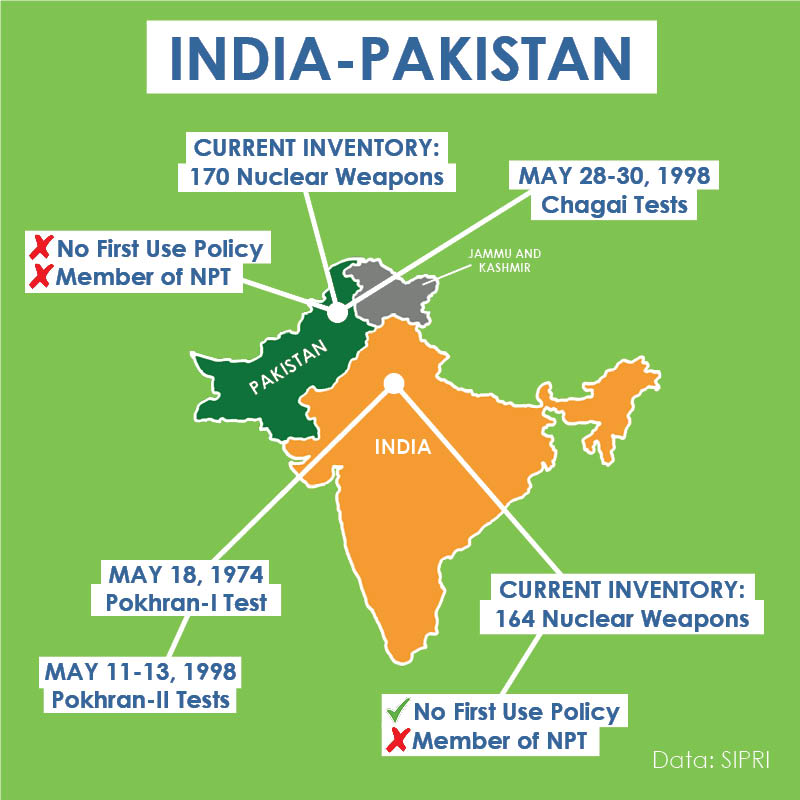It may be good that the latest armed conflict between India and Pakistan ended quickly before it could blow up into a full-scale war leading to massive destruction of life and property and economic disaster in both the countries – maybe more so in Pakistan than in India. However, the abrupt end of the conflict, which seriously damaged Pakistan’s military infrastructure, seemingly due to Pakistan’s possible nuclear threat is a matter of major concern. Of all the nine nuclear armed states, Pakistan is probably the world’s biggest terrorist state that had secretly sheltered the world’s most notorious, violent and wanted terrorist Osama bin Laden in an army cantonment area.
Pakistan’s ways are equally unpredictable. Formerly a close ally of the United States, Pakistan is now heavily dependent on China, militarily and economically. Reports suggest that a bewildered Pakistan, cornered by a barrage of Indian missile attacks on its military assets, was considering a nuclear response to teach India a lesson. Pakistan is the world’s seventh largest nuclear-armed power with some 170 nuclear warheads — all targeted at its single major enemy, India. Nuclear arms are Pakistan’s key weapon of mass destruction. Thankfully, Pakistan is yet to develop substantially other three weapons for the purpose – biological, chemical and radiological.
Unlike India, Pakistan pays little attention to the so-called nuclear doctrine. In the case of war with India, Pakistan will not even blink before using its nuclear warheads with the ‘first strike’ option if it finds an Indian military aggression deeply penetrating through its defences causing a major setback that can’t be reversed by conventional means. The ‘first nuclear strike’ option could be lethal as it can defeat the other belligerent nuclear power by destroying its arsenal to the point where the attacking country can survive the weakened retaliation while the opposing side is left unable to continue war. The Pakistan armed forces and government were clearly bamboozled by the extremely swift moves by the Indian defence forces that nearly rattled its war machinery.
In the early hours of May 10, Indian missiles hit Pakistan’s Nur Khan air base in Rawalpindi, where the headquarters of the nuclear-armed country’s military is located. A thoroughly confused Pakistan probably considered the nuclear option. It is possible that the US had a tip-off about Pakistan’s intention. India may deny but the White House had promptly responded by asking the two belligerent nations to go for immediate ceasefire. And, both sides agreed and the fight stopped abruptly. In fact, US President Donald Trump upstaged both New Delhi and Islamabad to announce a “full and immediate” India-Pakistan ceasefire hours before the Indian government and Pakistan Prime Minister Shehbaz Sharif confirmed the development.
Within days after the ceasefire, Prime Minister Narendra Modi served a strong message amid tensions with Pakistan, declaring that “India will not tolerate any nuclear blackmail.” In his first address to the nation after ‘Operation Sindoor’, Prime Minister Modi said, “No nuclear blackmail will be tolerated anymore. Terrorist attacks on India will have to face a befitting reply, and the response will be on our terms.” He said India will not be intimidated by nuclear threats. “Any terrorist safe haven operating under this pretext will face precise and decisive strikes,” the prime minister added. However, it may be difficult to entirely ignore the Pakistani ‘nuclear blackmail’ factor until the country is able to neutralise Pakistan’s nuclear war capability which is singularly directed towards India. Tiny Pakistan, only 25 percent of India’s geographical size, has as many as 170 nuclear warheads – 10 less than India’s, according to the think-tank Stockholm International Peace Research Institute (SIPRI). As of January 2024, SIPRI estimated there were 12,121 nuclear warheads worldwide. Of these, about 9,585 were held in military stockpiles, with 3,904 actively deployed – 60 more than the previous year. The US and Russia together account for more than 8,000 nuclear weapons.
Pakistan’s nuclear warheads can be delivered from the land and air. Pakistan is yet to have the sea delivery capability for its nuclear arsenal. Today, a single nuclear warhead can kill hundreds of thousands of people, with lasting and devastating humanitarian and environmental consequences. Jihadist Pakistan’s ‘nuclear blackmail’ can’t be taken lightly as the country had spent billions of dollars to build the nuclear arsenal and deployment system marking India as its sole target. It has developed long-range ballistic missiles which can deliver nuclear warheads even beyond 3,500 kilometres.
Pakistan’s longest-range missile system is the Shaheen-III, which was first tested in 2015 and had an estimated range of 2,750 kilometres. Pakistan is even ahead of Israel and North Korea in nuclear warhead stocks. Pakistan is reportedly one of the four countries yet to deploy nuclear warheads. The other three are: India, Israel and North Korea. However, deployment of nuclear warheads is not a big deal. They can be done within hours depending on the delivery system and the specific requirement. Intercontinental ballistic missiles (ICBMs) launched from land can be deployed within minutes. The same is the case of submarine-launched ballistic missiles (SLBMs).
Despite the massive production of nuclear weapons by the ‘Enabled Nine’ year after year, none of them has shown the courage to use them against their adversaries in a war since the first and the last nuclear strikes were made by the US, dropping atomic bombs on Hiroshima and Nagasaki towards the end of the 2nd World War in August, 1945. The US was the first country to produce atomic bombs during World War II as part of the Manhattan Project, testing the first nuclear weapon on July 16, 1945. Today, the nuclear weapons produced by China, France, India, Israel, North Korea, Pakistan, Russia, the United Kingdom and the US are several times more powerful than the nuclear weapons dropped on Hiroshima and Nagasaki. They are capable of decimating the entire world.
In this context, the two pertinent questions are: Will Jihadist Pakistan ever stop its frequent state-sponsored dangerous terrorist attacks on innocent Indians on Indian soil and ‘nuclear blackmail’? Probably not. A Jihadist nation, which can secretly shelter Osama bin Laden, the world’s most dreaded terrorist and mass murderer, and kidnap and butcher a young ‘The Wall Street Journal’ scribe, Daniel Pearl, near Karachi just because he was a Jew, can hardly be trusted. Pakistan’s nuclear threat against India may be real. (IPA Service)




